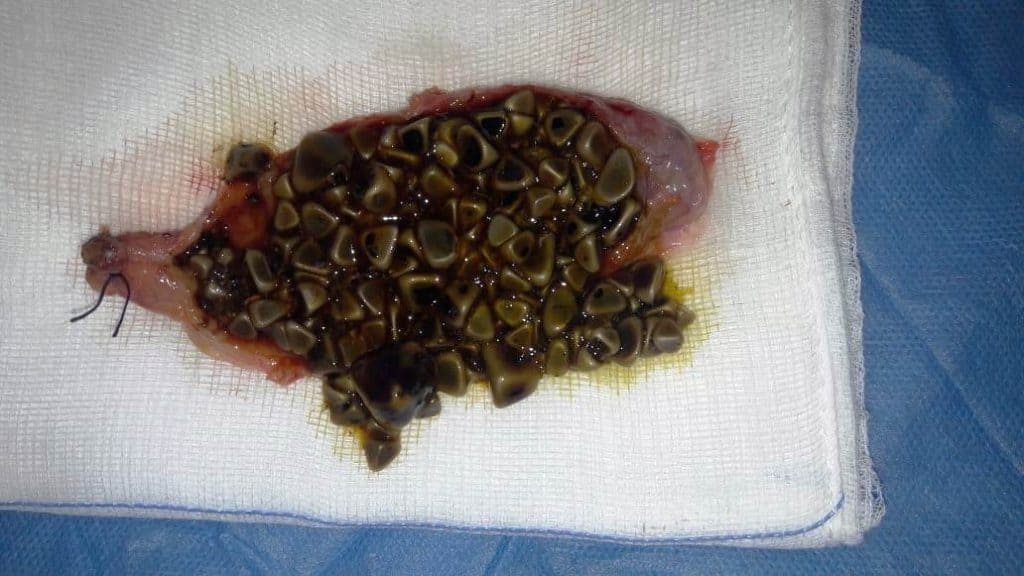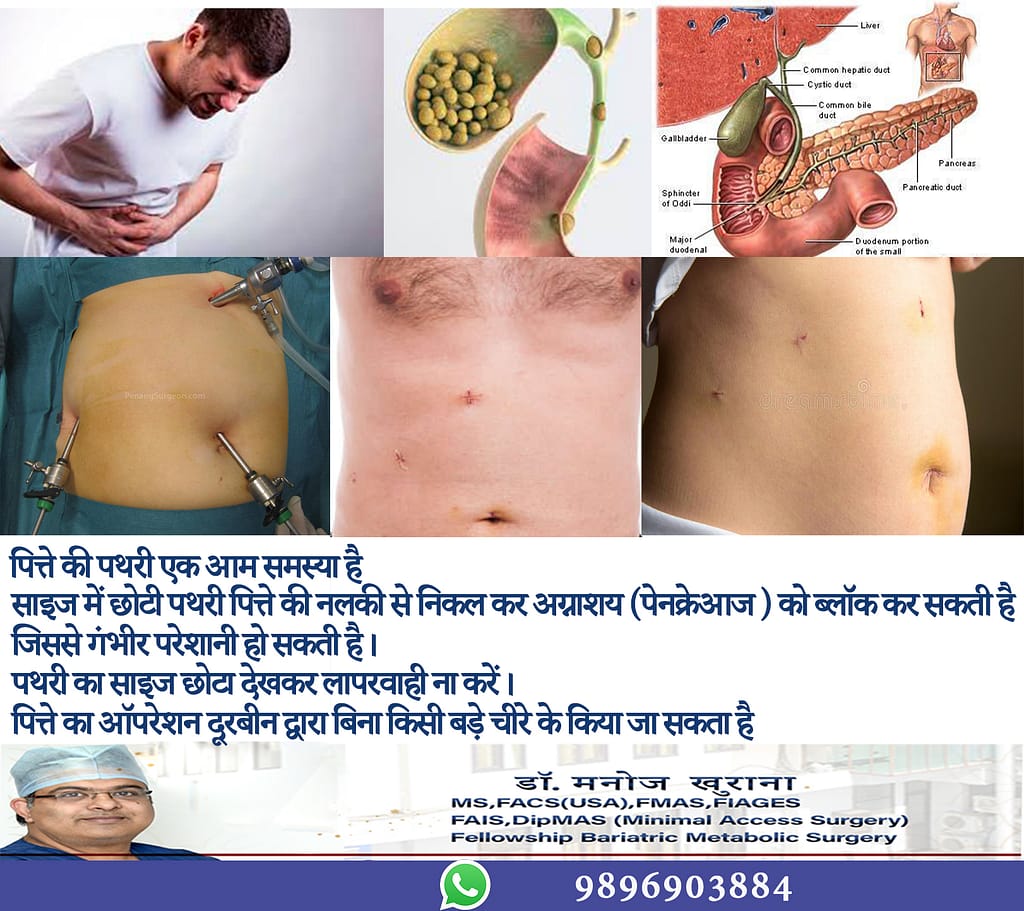Gallbladder stones (cholelithiasis) can be silent or cause unbearable pain on the right side of the tummy or pain radiating to the back if they get stuck in the neck of the gall bladder or duct. Our best gallbladder surgeon in Kurukshetra uses gallstone/gall bladder surgery (cholecystectomy) to resolve the condition effectively. Consult the best gallstone/ gall bladder surgeon and choose the benefits of laparoscopic surgery for gallstone treatment.
What are gallstones/ gallbladder stones?
Gallstones form in your gallbladder, the small, pear-shaped organ where your body stores bile ( a yellow-green colored food digestive juice formed by the liver ). They are pebble-like pieces of concentrated bile materials. Bile fluid contains cholesterol, bilirubin, bile salts and lecithin. Gallstones are usually made up of cholesterol or bilirubin that collect at the bottom of the gallbladder until they harden into “stones.”
Gallstones can be as small as a grain of sand or as big as a golf ball. They grow gradually, as bile continues to wash over them and they collect extra materials. Actually, it’s the smaller stones that are more likely to cause trouble. That’s because smaller stones can travel, while bigger ones tend to stay put. Gallstones that travel may get stuck somewhere mainly cystic duct or CBD common bile duct or pancreatic duct and create a blockage.

What is cholelithiasis?
Cholelithiasis is the condition of having gallstones/ gall bladder stones. Many people have cholelithiasis and don’t know it. Gallstones won’t necessarily cause any problems for you. If they don’t, you can leave them alone. But gallstones can sometimes cause problems by creating a blockage. This will cause pain and inflammation in your organs. If it goes untreated, it can cause serious complications.
How does having gallstones (cholelithiasis) affect me?
Your gallbladder is part of your biliary digestive system. It belongs to a network of organs that pass bile between each other. These organs are connected by a series of tubes called bile ducts. Bile travels through the bile ducts from your liver to your gallbladder, and from your gallbladder to your small intestine. Your pancreas also uses the bile ducts to deliver its own digestive juices.
A gallstone that travels to the mouth of your gallbladder can obstruct the flow of bile in or out. A gallstone that makes its way out of your gallbladder and into the bile ducts could block the flow of bile through the ducts. This will cause bile to back up into the nearby organs e.g. liver and pancreas. When bile backs up, it builds pressure and pain in your organs and bile ducts and causes inflammation.
This can lead to a variety of complications, including:
- Gallbladder disease. Gallstones are the most common cause of gallbladder diseases. When they get stuck, they cause bile to back up into your gallbladder, causing inflammation. This can do long-term damage to your gallbladder over time, scarring the tissues and stopping it from functioning. The stalled flow of bile also makes infections in your gallbladder more likely.
- Liver disease. A blockage anywhere in the biliary system can cause bile to back up into your liver. This will cause inflammation in your liver, leading to an increased risk of infection and long-term scarring over time (cirrhosis). If your liver stops functioning well, your whole biliary system breaks down. You can live without a gallbladder but not without a liver.
- Gallstone pancreatitis. A gallstone that blocks the pancreatic duct will cause inflammation in your pancreas. As with your other organs, temporary inflammation causes pain, and chronic inflammation causes long-term damage that can stop your organ from functioning.
- Cholangitis. Inflammation in your bile ducts can lead to infections in the short term and scarring in the long term. Scarring in your bile ducts causes them to narrow, which restricts the flow of bile. This can cause long-term bile-flow problems even after the blockage has been removed.
- Jaundice. Backed-up bile will leak into your bloodstream, making you sick. Bile carries toxins that your liver has filtered from your body. The bilirubin content has a yellow color, which will be visible in the whites of your eyes.
- Malabsorption. If bile can’t travel to your small intestine as intended, you might have difficulty breaking down and absorbing nutrients from your food. Bile is particularly important for breaking down fats and for absorbing fat-soluble vitamins in your small intestine.
Gallstone Risk Factors
You’re more likely to get gallstones if you:
- Have a family history of them
- Are a woman
- Are over age 40
- Are of Native American or Mexican descent
- Are obese
- Have a diet high in fat and cholesterol but low in fiber
- Don’t get much exercise
- Use birth control pills or hormone replacement therapy
- Are pregnant
- Have diabetes
- Have an intestinal disease like Crohn’s
- Have hemolytic anemia or cirrhosis of the liver
- Take medicine to lower your cholesterol
- Lose a lot of weight in a short time
- Are fasting
Can gallstones go away without surgery?
can gallstones be treated by homeopathy?
“ Gall bladder removal by surgery is the only final solution to the problem of gallstones. But many times, I come across patients who fear the surgery and look for ways to remove only the gallstones because they confuse gallstone treatment with kidney stones. See, both are different. Unlike kidney stones, where the kidney is healthy and the stone itself can be removed as a treatment, gallstones result from a diseased gallbladder. This is a very important point to be understood .gall stones develop in the gall bladder that has already lost its function. It can only lead to various complications so there is no benefit in keeping a diseased nonfunctional organ inside your body. This is why I suggest you do not trust just home remedies or quacks and seek good treatment as soon as possible. This will solve your problem from its core and allow you to live a better, healthy, and pain-free life. ”
Gall bladder surgery /Gall stone surgery
Gall bladder surgery specialists perform surgery to remove the gallbladder (cholecystectomy) which is the only way to cure gallstones. This can be done by conventional (open) method or a well-established endoscopic (laparoscopic) method which is now the Gold Standard. The gallbladder surgery is called “Laparoscopic Cholecystectomy” (Lap. Chole).
The surgeon makes a few tiny cuts in the abdomen and inserts surgical instruments thinner than a pencil and a miniature telescope with a mounted video camera into the abdomen. The camera sends a magnified image from inside the body to a video monitor, giving the surgeon a close-up view of the organs and tissues. While watching the monitor, the surgeon uses the instruments to carefully separate the gallbladder from the liver, ducts, and vessels.

The gallbladder is then removed through one of the small incisions. Recovery usually occurs within a few hours in most cases in the hospital, followed by a few days of rest at home. As there is no damage to the muscle (muscles are not cut) during laparoscopic surgery, patients have less pain and negligible wound complications.
If the surgeon finds any difficulty in the laparoscopic procedure, the operating team may decide to switch over to open surgery. It is called open surgery because the surgeon has to make a 5 to 8-inch incision in the abdomen to remove the gallbladder. Open surgery has faded into the background with the laparoscopic gallbladder surgery technique providing significant advantages and ease for the patient. The need for conversion in difficult cases is as low as 1-2 %.
Recovery after gall bladder surgery
you will be allowed to sit, take a walk, and have tea 4-6 hours after surgery in usual conditions. Discharge to home can be planned the next day. We advise having soft food for the next 2-3 days after that you can have a normal meal prepared at home with less butter and oil. you can take a shower and use stairs and within 5-6 days you are allowed to resume your duties.
